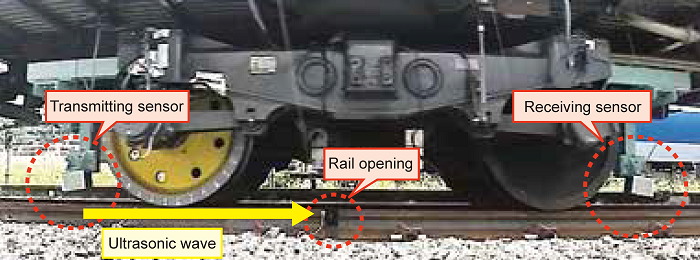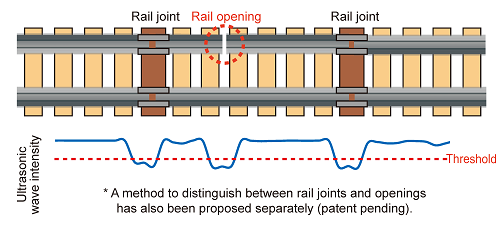26. Non-contact method to detect rail openings using aerial ultrasonic waves
Currently, rail breakages are detected along with the train position by the track circuit, but if a wireless train control system is introduced, a separate method of detecting rail breakage is required. Therefore, we have devised a method to detect rail openings based on the intensity of ultrasonic waves that were transmitted to the rails from the vehicle and received by an aerial ultrasonic sensor without contact (Fig. 1).
When ultrasonic waves are input from the sensor to the rail through the air, the transmittance is extremely low, about 1/10,000th of the transmittance when the sensor is in direct contact with the rail. For this reason, we have adopted a system that can transmit and receive ultrasonic waves more powerful than those used in general ultrasonic testing, and that can strongly amplify the strength of the received waves. In addition, in order to minimize the attenuation of ultrasonic waves due to sensor separation and vibration, we used a relatively low-frequency band of 100 kHz among ultrasonic waves. In order to facilitate the judgment, we have also proposed a method to distinguish from rail joints and a method to convert the received ultrasonic wave intensity into a time history waveform and display it. In addition, we conducted laboratory test and confirmed that the system could detect even when the rail ends were in contact with each other, which cannot be detected with track circuits.
As the result of a running test conducted on a test line using a testing car equipped with this system at speeds up to 80 km/h, we have confirmed that the system can transmit and receive ultrasonic waves to and from the rail and that the ultrasonic wave intensity decreases at the rail openings (Figs. 2 and 3). At present, we still have some issues, such as the inclusion of noise in the received waveform when a squeal noise is generated on a curve. We will continue to improve the system and aim to put it to practical use.
Other Contents
- 22. Numerical simulation of ventilation in a vehicle by opening windows while running
- 23. Analytical evaluation method for the speed at which hunting occurs
- 24. Evaluation of the influence of wheel machining marks on the friction coefficient by visualizing the contact area
- 25. Wheel slide protection simulator to supplement on-track testing
- 26. Non-contact method to detect rail openings using aerial ultrasonic waves
- 27. Clarification of wear mechanism of current collecting materials caused by frictional heat
- 28. Method to evaluate physical properties of frictional materials by numerical simulation
- 29. Detection of changes in drivers' physical and mental state using physiological indicators
- 22. Numerical simulation of ventilation in a vehicle by opening windows while running
- 23. Analytical evaluation method for the speed at which hunting occurs
- 24. Evaluation of the influence of wheel machining marks on the friction coefficient by visualizing the contact area
- 25. Wheel slide protection simulator to supplement on-track testing
- 26. Non-contact method to detect rail openings using aerial ultrasonic waves
- 27. Clarification of wear mechanism of current collecting materials caused by frictional heat
- 28. Method to evaluate physical properties of frictional materials by numerical simulation
- 29. Detection of changes in drivers' physical and mental state using physiological indicators



